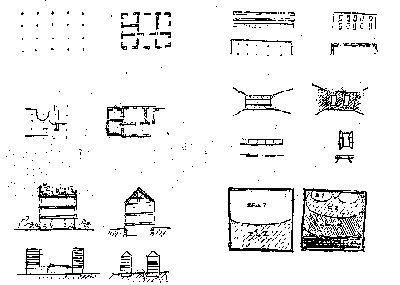
These points were illustrated best in Le Corbusier's domestic architecture.
Le Corbusier's first attempt to deal with the problem of mass housing was Maisons Citrohan, designed in 1920-22. All parts of the house are united by a spatial continuum, while the open space created by the pilotis and the flat roof increase the otherwise small available area. The prototype of a single-family unit, which was later modified to a module within a collective building, for example the basic units of the Immeuble-villa (1922).
Le Corbusier established his concept of the dwelling as standardized, mass produced and serviceable like the modern car. Citrohan 2 implies the elements of the Dom-Ino constructural system, that is the use of a reinforced concrete frame. Citrohan 2 introduced ideas of Le Corbusier's '5 Points of New Architecture': the building raised off the ground on pilotis, which 'free' the ground for vehicular circulation and for services. The roof-garden or terrace, which is clearly established in the Citrohan projects as a component of private, domestic space.

(a) Maison La Roche-Jeanneret, (b) Villa Stein, (c) Villa at Carthage, (d) Villa Savoye
The Cook House or Maison Cook in Boulogne-sur-Seine (1926) was a terrace house, an almost perfect prototype for a small, single-family urban dwelling, employed several of Le Corbusier's ideas. The ground floor was almost entirely open; which contained parking space for a car, a small-enclosed entry and stair hall, and a paved and planted open terrace. The upper floors were supported on a few concrete pilotis.
As at Citrohan, the living room extended upward through two storeys, and a portion of the roof used as a spacious garden terrace. Also, special in the Maison Cook was the extremely free handling of partitions. On every floor level Le Corbusier made a point of curving his partitions to make it quite clear that they were entirely independent of all structural supports.
Having assured himself of the 'Five Points' in the design of the Maison Cook, Le Corbusier was about to explore further possibilities of the system. The sytem led to practical advantages as well as spatial and formal flexibility. The Villa Stein which Le Corbusier built at Garches during 1927. Again, pilotis supporting a part of the ground floor; a hollowed-out, two storey outdoor cube; freely curved partitions on every floor; a 'Golden Section' system of facade design; and a roof garden on top. The villa was another contribution towards Le Corbusier's central objective - to create prototypes for a vertical city. Villa Stein possessed a sculptured stairs and suspended entrance canopies, the long, uninterrupted ribbon windows. Also, both its short end walls are blank, or almost blank, as Garches was designed again as a unit in a repetitive block of 'superimposed villas'.
The 2 Houses Le Corbusier built at Weissenhof Siedlung in Stuttgart (1927), were an experimental building to the modern suburb. Le Corbusier felt fully justified in making his Weissenhof buildings a kind of summary of all his convictions concerning an industrialized architecture.
The first Weissenhof building was a precise and beautifully proportioned version of his Citrohan project of 1922. It repeated the clearly defined roof garden on top, and free facade glazed by large rectangles of glass, like an abstract painting. The second building was an actual apartment house. The building had single-level apartments on the second floor, and a roof garden on top. The stair towers were treated as separate elements, projecting out from the 'pure prism' of the apartment block. A ribbon of glass consisting of horizontally sliding windows extended across the full length of the building. All partitions inside consisted of prefabricated storage walls, and all furniture, apart from chairs and tables, was built in also.
Villa Savoye was part of the central concept that Le Corbusier first developed in the Citrohan house in 1922. It revealed the same language traced as far as Villa Stein, but rearranged in a slightly different way. The villa at Poissy was also a realization of the 'five points'. As well as demonstrating these, it also has the characteristic elements such as the entrance ramp (which cuts through the middle of the grid), the curving walls of the solarium and, the pilotis and slab construction.
Once inside the ground floor, one can promenade through either by a ramp or a curving staircase. The first floor, surrounded entirely by a ribbon window, consisted of the complete lining accommodation wrapped in the open terrace. Light and air penetrated everywhere. Direct contact with the surrounding landscape is achieved by various openings, views are framed like a picture.




